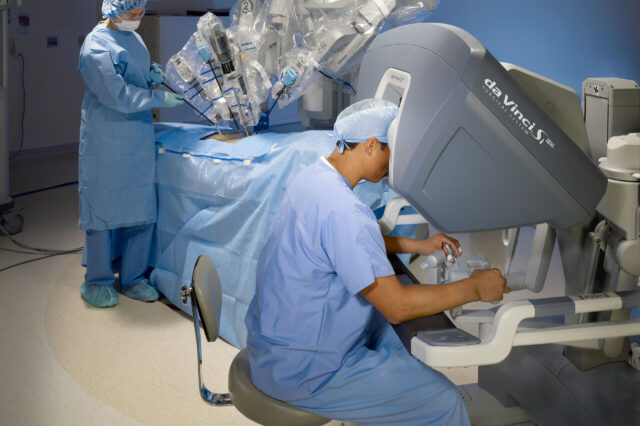When diagnosed with a heart condition requiring surgery, it’s important to understand your options.
Cardiothoracic surgeons at the UF Health Cardiovascular Center work in close collaboration with a team of cardiology specialists to determine the procedures best suited for your specific condition. More frequently, the best option can be minimally invasive surgery.
Why choose UF Health Jacksonville?
- Since 1999, UF Health Jacksonville surgeons have pioneered minimally invasive surgery techniques, many of which have become the standard of care for other hospitals.
- Our center is now the most advanced minimally invasive cardiac surgery center in the region and provides more options for minimally invasive and robotically assisted surgeries than anywhere else in Northeast Florida and Southeast Georgia.
- With our expertise, we can help patients achieve optimal outcomes for a lengthened and better quality of life. Our surgeons and cardiologists take a team approach in assessing each patient and create a customized treatment plan to meet your individual needs.
Who qualifies?
Most patients who are candidates for surgery are experiencing valvular heart disease that has damaged one of three heart valves causing them to be too hard and narrow to fully open (stenotic), or unable to completely close. These are:
- Mitral and tricuspid – These two valves regulate blood flow between the atria (upper chambers of the heart that collect and eject blood) and the ventricles (the lower chambers of the heart that collect and eject blood)
- Aortic – This valve controls blood flow between the heart and the aorta (the main artery of the body)
Valvular heart disease most often affects the mitral valve or the aortic valve and surgery is required when other treatment options either fail or are not appropriate. You may be a candidate for minimally invasive and robotic cardiac surgery if:
- You have aortic regurgitation, meaning that your aortic valve does not close all the way so blood leaks back into your heart.
- You have aortic stenosis, meaning that your aortic valve does not open fully so blood flow out of the heart is blocked.
How it works
When surgery is necessary on the aortic valve (the valve that controls blood flow between the heart and the aorta artery), your surgeon makes a small vertical incision in the upper breastbone (mini-sternotomy) or in between the second and third ribs to the right of the breastbone (parasternal incision) and insert a tiny camera and robotic instruments for surgery.
The outcomes of the two different approaches are the same. During the procedure, your surgeon will generally connect you to a heart-lung machine through blood vessels in the groin, so there will be a small incision there as well.
When surgery is necessary on the mitral or tricuspid valves (the valves that control blood flow between the upper and lower chambers of the heart), your surgeon makes small incisions in the right side of the chest and insert a tiny camera and robotic instruments for surgery. The surgeon will also connect you to a heart-lung machine through the groin. Oftentimes, your surgeon will be able to repair the mitral and tricuspid valves using your own tissue. If repair is not possible, your surgeon can also replace the valves.
Benefits
Minimally invasive surgery has many benefits over traditional surgery, including:
- Quicker recovery
- Shorter hospital stay
- Less pain and scarring
- Less risk of infection
- Less blood loss and fewer transfusions
- Quicker return to normal activities
- Decreased need for post-surgery medications
- Smaller, less obvious incision
What to expect
During the operation, your surgeon will start by making two to four tiny cuts in your chest through which he can insert the robotics to conduct the procedure as well as a small camera.
Using a special computer that controls the robotic arms, your surgeon views a 3D image of the heart on a screen in the operating room to guide the procedure. After the needed repairs or replacements have been made, the surgeon removes the robotic arms and camera, and closes the small incisions with stitches.
Recovery
Recovery from minimally invasive and robotic cardiac surgery is generally much easier and faster than traditional open-heart surgery. However, you should still expect to take some down time from your normal activities and work. Your recovery plan will be tailored to your individual needs, but you can generally expect:
- A prescription for medicine to help control the pain, so you can relax and heal more effectively
- A prescription medicine to prevent blood clots from forming in your replacement valve; you may need to take it for about six months after surgery
- Instructions on how to care for your incision site, such as how to dress and cover the wound, and how to bathe while it heals
- Education on how to follow a heart-healthy diet that includes plenty of fruits and vegetables, lean proteins, low-fat dairy and whole grains; you may need to avoid foods that are high in salt, cholesterol and saturated fats
- The opportunity to attend regular cardiovascular rehabilitation once you are ready to return to physical activity
Your surgeon will speak with you about your recovery and any related restrictions before you leave the hospital.
Related conditions & treatments
- Atrial septal defect
- Cardiac rehabilitation
- Left atrial appendage closure (Watchman)
- Minimally invasive and robotic thoracic surgery
- Minimally invasive surgery
- Patent foramen ovale
- Robotic surgery
- Structural heart and valvular disease
- Transcatheter aortic valve replacement (TAVR)
- Transcatheter mitral valve repair (MitraClip)

